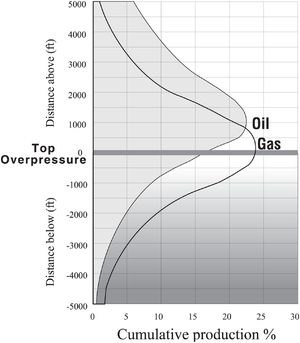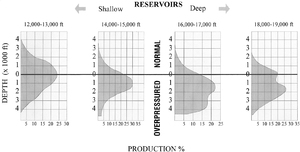Difference between revisions of "Overpressure and hydrocarbon distribution, Gulf Coast"
Cwhitehurst (talk | contribs) |
Cwhitehurst (talk | contribs) m (added Category:Treatise Handbook 3 using HotCat) |
||
| (13 intermediate revisions by 2 users not shown) | |||
| Line 6: | Line 6: | ||
| part = Predicting the occurrence of oil and gas traps | | part = Predicting the occurrence of oil and gas traps | ||
| chapter = Evaluating top and fault seal | | chapter = Evaluating top and fault seal | ||
| − | | frompg = 10- | + | | frompg = 10-62 |
| − | | topg = 10- | + | | topg = 10-63 |
| author = Grant M. Skerlec | | author = Grant M. Skerlec | ||
| link = http://archives.datapages.com/data/specpubs/beaumont/ch10/ch10.htm | | link = http://archives.datapages.com/data/specpubs/beaumont/ch10/ch10.htm | ||
| Line 14: | Line 14: | ||
| isbn = 0-89181-602-X | | isbn = 0-89181-602-X | ||
}} | }} | ||
| − | Studies of the [[hydrocarbon distribution]] in the Gulf Coast relative to the top of overpressure suggest hydraulic fracturing and seal integrity influence the vertical distribution of | + | Studies of the [[hydrocarbon distribution]] in the Gulf Coast relative to the top of [[Overpressure causes|overpressure]] suggest [[Natural hydraulic fracturing of top seals|hydraulic fracturing]] and [[Seal failure prediction|seal integrity]] influence the vertical distribution of [[hydrocarbon]]s, success ratios, and [[Risk:_expected_value_and_chance_of_success#Probability_of_geological_success|seal risk]].<ref name=ch10r30>Fertl, W. H., and W. G. Leach, 1988, Economics of hydrocarbon reserves in overpressured reservoirs below 18,000 feet in south Louisiana: SPE paper 18146, 16 p.</ref><ref name=ch10r46>Leach, W. G., 1993a, Fluid migration, HC concentration in south Louisiana Tertiary sands: Oil & Gas Journal, vol. 91, no. 11, p. 71–74.</ref><ref name=ch10r47>Leach, W. G., 1993b, Maximum hydrocarbon window determination in south Louisiana: Oil & Gas Journal, vol. 91, no. 13, p. 81–84.</ref> |
==Success rate vs. depth== | ==Success rate vs. depth== | ||
| − | [[file:evaluating-top-and-fault-seal_fig10-45.png|thumb|{{figure number|1}} | + | [[file:evaluating-top-and-fault-seal_fig10-45.png|thumb|300px|{{figure number|1}}Distribution of oil and gas production from more than 20,000 wells.<ref name=ch10r47 /> Copyright: Oil & Gas Journal.]] |
| − | The chance of finding an economically successful accumulation in the Gulf Coast decreases with depth. This decrease is a result of several changes, including [[reservoir quality]] and [[migration pathway]]s. Most importantly, however, the distribution of hydrocarbons is closely related to the top of the overpressure zone. [[:file:evaluating-top-and-fault-seal_fig10-45.png|Figure 1]] shows the distribution of oil and gas production from more than 20,000 wells. Most hydrocarbons are found near or slightly above the top of the overpressured zone. The chance of success is reduced by 90–95% at depths of 2,000–5,000 ft below the top of overpressure.<ref name=ch10r47 /> | + | The chance of finding an economically successful [[accumulation]] in the Gulf Coast decreases with depth. This decrease is a result of several changes, including [[reservoir quality]] and [[migration pathway]]s. Most importantly, however, the distribution of hydrocarbons is closely related to the top of the [[Overpressure causes|overpressure]] zone. [[:file:evaluating-top-and-fault-seal_fig10-45.png|Figure 1]] shows the distribution of oil and gas production from more than 20,000 wells. Most hydrocarbons are found near or slightly above the top of the overpressured zone. The chance of success is reduced by 90–95% at depths of 2,000–5,000 ft below the top of overpressure.<ref name=ch10r47 /> |
| − | == | + | ==Hydrocarbon distribution vs. overpressure== |
| − | |||
| − | + | [[file:evaluating-top-and-fault-seal_fig10-46.png|thumb|300px|{{figure number|2}}Distribution of hydrocarbons relative to the top of overpressure changes as reservoir depth changes.<ref name=ch10r47 /> Copyright: Oil & Gas Journal.]] | |
| − | [[file:evaluating-top-and-fault-seal_fig10-46.png| | + | The distribution of hydrocarbons relative to the top of [[Overpressure causes|overpressure]] changes as [[reservoir]] depth changes is shown in [[:file:evaluating-top-and-fault-seal_fig10-46.png|Figure 2]]. This pattern is consistent with loss of [[Seal failure prediction|top seal integrity]] because of [[Natural hydraulic fracturing of top seals|hydrofracturing]] rather than a simple loss of reservoir quality or other variable. Deeper reservoirs have the peak gas occurrence below the top of overpressure. This is consistent with the changing amount of pressure required to [[fracture]] the top seal (P<sub>f</sub>) with depth. As depth increases, confining pressure increases and thus the P<sub>f</sub> increases. As fracture pressure increases, the depth of the first [[intact top seal]] increases. |
| + | |||
| + | The relationship between depth of reservoir and depth of maximum cumulative production below the top of overpressure is fundamental to [[Risk:_expected_value_and_chance_of_success#Probability_of_geological_success|seal risk]]. Further work is required to relate the distribution of hydrocarbons to actual fracture pressure rather than simply depth below top of overpressure. | ||
==See also== | ==See also== | ||
| − | |||
* [[Natural hydraulic fracturing of top seals]] | * [[Natural hydraulic fracturing of top seals]] | ||
* [[Fracture threshold in the real world]] | * [[Fracture threshold in the real world]] | ||
| Line 45: | Line 45: | ||
[[Category:Predicting the occurrence of oil and gas traps]] | [[Category:Predicting the occurrence of oil and gas traps]] | ||
[[Category:Evaluating top and fault seal]] | [[Category:Evaluating top and fault seal]] | ||
| + | [[Category:Treatise Handbook 3]] | ||
Latest revision as of 20:30, 30 March 2022
| Exploring for Oil and Gas Traps | |

| |
| Series | Treatise in Petroleum Geology |
|---|---|
| Part | Predicting the occurrence of oil and gas traps |
| Chapter | Evaluating top and fault seal |
| Author | Grant M. Skerlec |
| Link | Web page |
| Store | AAPG Store |
Studies of the hydrocarbon distribution in the Gulf Coast relative to the top of overpressure suggest hydraulic fracturing and seal integrity influence the vertical distribution of hydrocarbons, success ratios, and seal risk.[1][2][3]
Success rate vs. depth

The chance of finding an economically successful accumulation in the Gulf Coast decreases with depth. This decrease is a result of several changes, including reservoir quality and migration pathways. Most importantly, however, the distribution of hydrocarbons is closely related to the top of the overpressure zone. Figure 1 shows the distribution of oil and gas production from more than 20,000 wells. Most hydrocarbons are found near or slightly above the top of the overpressured zone. The chance of success is reduced by 90–95% at depths of 2,000–5,000 ft below the top of overpressure.[3]
Hydrocarbon distribution vs. overpressure

The distribution of hydrocarbons relative to the top of overpressure changes as reservoir depth changes is shown in Figure 2. This pattern is consistent with loss of top seal integrity because of hydrofracturing rather than a simple loss of reservoir quality or other variable. Deeper reservoirs have the peak gas occurrence below the top of overpressure. This is consistent with the changing amount of pressure required to fracture the top seal (Pf) with depth. As depth increases, confining pressure increases and thus the Pf increases. As fracture pressure increases, the depth of the first intact top seal increases.
The relationship between depth of reservoir and depth of maximum cumulative production below the top of overpressure is fundamental to seal risk. Further work is required to relate the distribution of hydrocarbons to actual fracture pressure rather than simply depth below top of overpressure.
See also
- Natural hydraulic fracturing of top seals
- Fracture threshold in the real world
- Natural hydraulic fracturing example, North Sea
References
- ↑ Fertl, W. H., and W. G. Leach, 1988, Economics of hydrocarbon reserves in overpressured reservoirs below 18,000 feet in south Louisiana: SPE paper 18146, 16 p.
- ↑ Leach, W. G., 1993a, Fluid migration, HC concentration in south Louisiana Tertiary sands: Oil & Gas Journal, vol. 91, no. 11, p. 71–74.
- ↑ 3.0 3.1 3.2 3.3 Leach, W. G., 1993b, Maximum hydrocarbon window determination in south Louisiana: Oil & Gas Journal, vol. 91, no. 13, p. 81–84.